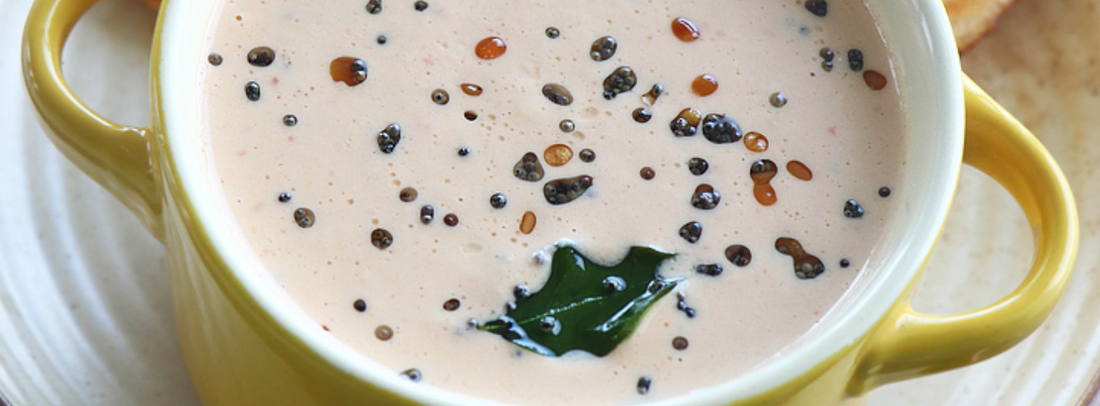Peanut chutney or groundnut chutne is a staple in South Indian cuisine, known for its rich, nutty flavor and smooth texture. Made from roasted peanuts, chilies, and tamarind, it pairs perfectly with idli, dosa, or snacks.
For restaurants, peanut chutney is more than a condiment, it’s a versatile, budget-friendly way to add authentic flavor to multiple dishes. In this guide, Kimecopak.ca shares how to make Peanut Chutney perfectly, store it safely, and use it creatively across your menu.
- Best Apple Chutney Recipe for Business
- Beetroot Chutney: A Flavorful Guide for Chefs
- Exploring Garlic Chutney for Better Business
What Is Peanut Chutney?
Peanut chutney is a creamy, savory condiment made primarily from roasted peanuts, chili, garlic, tamarind, and select spices. Its roots lie in South Indian cuisine, though it is now enjoyed throughout India with countless local adaptations.
While the essential base remains the same roasted peanuts providing richness and texture the supporting ingredients vary regionally, resulting in versions that can be spicy, tangy, sweet, or earthy. Its versatility is what makes peanut chutney a culinary favorite among chefs looking to create balance and contrast in their dishes.

Regional Variations of Peanut Chutney
Andhra-Style Peanut Chutney
Originating from the southern state of Andhra Pradesh, this variation is known for its bold, fiery heat. It typically includes dried red chilies, garlic, and tamarind. Some versions also incorporate sautéed onions or curry leaves for added aroma. This chutney pairs perfectly with dosas, idlis, and steamed rice, offering a punch of spice that complements mild dishes.
Flavor profile: Spicy, tangy, and aromatic
Best served with: Idli, dosa, and upma
Maharashtrian-Style Peanut Chutney (Shengdana Chutney)
In Maharashtra, peanut chutney often takes a dry, powdered form, made by roasting peanuts, sesame seeds, and dried coconut together. It’s usually seasoned with red chili powder and salt, then served as a side condiment with flatbreads like bhakri or mixed into rice with ghee.
Flavor profile: Nutty, toasty, and slightly smoky
Best served with: Bhakri, chapati, or steamed rice
Tamil Nadu-Style Peanut Chutney
This variant is mild and coconut-forward, often using green chilies and fresh coconut. It’s finished with a tempering of mustard seeds, curry leaves, and urad dal — a technique known as tadka that enhances flavor and aroma.
Flavor profile: Mildly spicy, creamy, and fresh
Best served with: Dosa, idli, and pongal
Karnataka-Style Peanut Chutney
A Karnataka specialty, this chutney blends peanuts with jaggery, tamarind, and coconut for a sweet-tangy balance. It’s less spicy than its Andhra counterpart and has a smooth, buttery texture that complements breakfast dishes beautifully.
Flavor profile: Sweet, tangy, and nutty
Best served with: Ragi dosa, masala dosa, or vada
Why Peanut Chutney Stands Out in Restaurant Menus

For chefs and food entrepreneurs, peanut chutney represents more than a condiment, it’s a menu differentiator. Here’s why:
- Cost-effective ingredient base: Peanuts are affordable and available year-round.
- Nutrient-rich appeal: High in protein, fiber, and healthy fats perfect for health-conscious diners.
- Versatile usage: Works across breakfast, lunch, and dinner menus.
- Longer shelf life: Can be refrigerated or frozen for extended use, reducing food waste.
- Customizable flavor: Easily adapted with herbs, citrus, or other nuts for signature blends.
Restaurants that focus on regional authenticity or plant-forward menus can use peanut chutney to elevate both flavor and nutritional value especially when paired with eco-friendly packaging from Kimecopak.ca that keeps sauces fresh and sustainable during storage or takeaway service.
How to Make Peanut Chutney?
Ingredients
- 1 cup roasted peanuts (unsalted, high quality)
- 2–3 dried red chilies (adjust for spice level)
- 2 cloves garlic
- ½ teaspoon cumin seeds
- 1 tablespoon tamarind paste
- 1 teaspoon jaggery or brown sugar
- Salt to taste
- ½–¾ cup water (adjust for desired consistency)
Optional Tempering (Tadka)
- 1 teaspoon oil
- ½ teaspoon mustard seeds
- 1 sprig curry leaves
- 1 dried red chili (broken)
Equipment
Here are necessary tools for preparation:
- Heavy-bottomed skillet or non-stick pan
- Blender or mortar & pestle
- Saucepan for tempering
- Airtight glass container for storage

Step-by-Step Instructions: How to Make Peanut Chutney
Step 1: Roast the peanuts
Heat the peanuts in a dry skillet over medium heat until fragrant and lightly browned. Be careful not to burn them. Roasting the peanuts adds a depth of flavor and enhances their nutty aroma.
Step 2: Grind spices, peanuts, and garlic
Combine the roasted peanuts, chili peppers, cumin seeds, and garlic in a mortar and pestle or a blender. Grind until a smooth paste forms. The grinding process releases the essential oils and flavors of the ingredients, creating the foundation for the chutney.
Step 3: Combine ingredients
Add the tamarind paste, jaggery, salt, and water to the ground mixture. Stir until well combined. Tamarind paste provides a tangy and slightly sweet flavor, while jaggery adds a natural sweetness that balances the spiciness. Salt enhances the overall taste, and water adjusts the consistency.
Step 4: Simmer the chutney
Transfer the mixture to a saucepan and cook over low heat for 5-7 minutes, stirring occasionally. Simmering helps to develop the flavors of the ingredients and thickens the chutney. It also ensures that the tamarind paste is fully incorporated, creating a harmonious blend of tastes.
Step 5: Adjust consistency and flavor
Taste the chutney and adjust the seasonings as needed. Add more water for a thinner consistency if you prefer a more runny chutney, or add more salt for a saltier flavor. The key is to achieve a balance that suits your personal taste preferences.
Step 6: Cooling and storing
Remove the chutney from the heat and let it cool completely before storing. This allows the flavors to meld and the chutney to set. Store in an airtight container in the refrigerator for up to a week. Properly storing the chutney will help it retain its freshness and flavor.
Pro Variations for Restaurant Menus
Elevate your peanut chutney by experimenting with these creative twists that cater to diverse customer preferences:
1. Mint Peanut Chutney
Add a handful of fresh mint leaves and a squeeze of lemon juice. The freshness cuts through the richness, making it ideal for grilled snacks or wraps.
2. Cilantro Peanut Chutney
Blend fresh cilantro for a bright, herbal note that pairs well with rice dishes and tandoori platters.
3. Spicy Garlic Peanut Chutney
Increase garlic and chili content for a fiery, robust version — a perfect match for spicy mains.
4. Coconut Peanut Chutney
Add grated coconut to balance spice and add natural sweetness. Great with South Indian breakfast items.
5. Roasted Tomato Peanut Chutney
Blend in roasted tomatoes for a tangy, smoky twist that enhances sandwiches, burgers, or grilled vegetables.
6. Curry-Infused Peanut Chutney
Add a pinch of curry powder or turmeric for an aromatic golden hue and complex depth of flavor.
Chef’s Note: Peanut chutney can also be made vegan, gluten-free, and oil-free, depending on your restaurant’s dietary focus.
Serving Suggestions
As mentioned above, peanut chutney is a versatile condiment that pairs well with a variety of Indian dishes. Here are some popular serving suggestions you should know to divers your restaurant menu:
- Dosa: A thin, crispy crepe made from fermented rice and lentil batter, dosa is often served with peanut chutney as a dipping sauce. The tangy and slightly spicy chutney complements the savory and slightly sour flavor of the dosa.
- Idli: Steamed rice cakes made from fermented rice and lentil batter, idli is another classic South Indian dish that is often served with peanut chutney. The chutney adds a burst of flavor and helps to balance the mild taste of the idli.
- Uttapam: A thick, pancake-like dish made from fermented rice and lentil batter, uttapam is often topped with various toppings, including onions, tomatoes, and chili peppers. Peanut chutney can be served as a dipping sauce for uttapam or spread on top for an extra layer of flavor.
- Sambar: A lentil stew made with vegetables and spices, sambar is a staple in South Indian cuisine. Peanut chutney is often served as a side dish to sambar, adding a contrasting flavor and texture.
- Masala dosa: A variation of the classic dosa that is filled with a masala (spiced potato filling), masala dosa is often served with peanut chutney and sambar. The chutney provides a refreshing and tangy counterpoint to the savory and spicy filling of the dosa.
Peanut Chutney FAQ

Can peanut chutney be made without tamarind?
Yes. You can substitute tamarind with lemon or lime juice for tanginess. The flavor will be brighter and slightly less earthy.
How can I make my chutney thicker?
Add fewer water portions or include a small handful of roasted chickpeas or sesame seeds for texture.
Can I freeze peanut chutney for bulk preparation?
Absolutely. Freeze in small batches using silicone molds. Defrost only what you need, it helps maintain freshness and reduce waste.
Is peanut chutney vegan-friendly?
Yes, it’s naturally vegan. Just ensure you skip ghee or dairy-based tempering.
What dishes pair best with peanut chutney for restaurant menus?
It pairs beautifully with idli, dosa, pakoras, wraps, sandwiches, grilled meats, or even rice bowls.
How long can peanut chutney last in the fridge?
When stored properly, it remains fresh for 5–7 days. Always use clean utensils to avoid contamination.
What’s the difference between peanut chutney and groundnut sauce?
Peanut chutney is Indian, with spices like tamarind, chili, and garlic. Groundnut sauce (common in African cuisine) is thicker and often cooked with vegetables or meats.
Conclusion
Peanut chutney captures the essence of Indian culinary tradition rich, spicy, and endlessly adaptable. Its versatility makes it an excellent addition to restaurant menus, whether you’re serving traditional South Indian breakfasts, global fusion dishes, or healthy modern meals.
By mastering the recipe and exploring creative variations, chefs can turn this humble condiment into a signature offering. Combine that with sustainable packaging solutions from Kimecopak.ca, and you not only deliver exceptional flavor but also showcase environmental responsibility.
So, whether you’re a chef designing your next menu or a restaurant owner seeking standout flavors, peanut chutney is a simple yet powerful way to impress your guests, one spoonful at a time.







